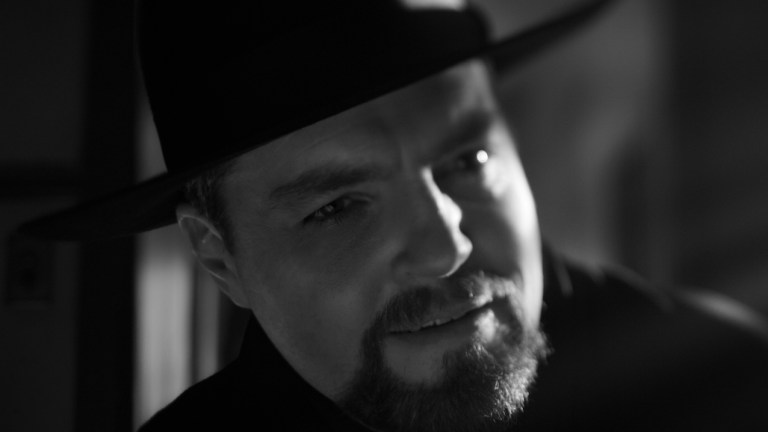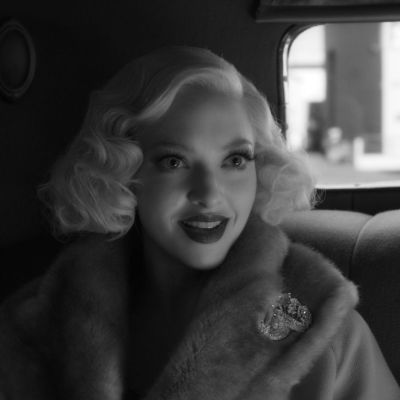What the Mank Ending Leaves Out About Orson Welles and Citizen Kane
We dive into the Mank ending and explore where the story of Orson Welles stealing screenplay credit from Herman J. Mankiewicz came from... and why it's wrong.

This article contains Mank spoilers. You can read our review here.
It’s like the climax of a Western. Two men stare across from each other in a showdown of ego and calculation. And Gary Oldman’s Herman J. Mankiewicz (or “Mank”) has just told Orson Welles (Tom Burke) he wants writing credit for the Citizen Kane screenplay. This is not going to end well.
Before this moment, Welles had been conciliatory to Mank, feigning concern for his health and offering to take sole rewriting duties on the gargantuan script. He’s even providing $10,000 from RKO Pictures as a consolation. It’s of course more bribe than bonus. Yet as Welles realizes that he might have to share credit, or worse have no credit at all for a screenplay we just watched Mankiewicz write alone for two hours, the budding director throws a temper tantrum worthy of Charles Foster Kane, and Mankiewicz uses it as inspiration for exactly that—hubris run amok.
In the end, Welles is unmasked as a bully and an opportunist: a charlatan who wants to claim credit for a masterful screenplay that is all Mank’s, at least according to Mank. Yet the movie’s “Boy Genius from New York” wasn’t smart enough to see the writing on the wall about how the newly formed Screen Writers Guild would arbitrate this, nor did he predict that when Mank finally accepted his eventual screenwriting Oscar from his front lawn he’d say, “I am very happy to accept this award in the manner in which the screenplay was written, which is to say in the absence of Orson Welles.”
Is all this true? Did Welles put his name on a screenplay he didn’t help write a word of? It’s a question that has bedeviled the legend of Citizen Kane for 50 years, and even longer if you consider how many decades before that most people just believed the “Boy Genius” created everything substantial in Kane out of whole cloth. That myth is perhaps why Pauline Kael created one of her own when she published her 50,000-word essay “Raising Kane” across two volumes in The New Yorker in 1971—an account of Citizen Kane’s creation that suggests Mankiewicz alone wrote the script.
The Influence of Pauline Kael and “Raising Kane”
Kael’s essay, which is the clear basis for Mank, has been discredited in the ensuing years as inaccurate, unfair to Welles, and at best sloppy (or at worst intentionally misleading). But it makes for a hell of a story, which five decades on still finds life in David Fincher’s new Netflix film.
“Orson Welles wasn’t around when Citizen Kane was written, early in 1940,” Kael emphatically stated midway through the first volume of “Raising Kane.” Rather, she’d eventually elaborate, he was too “deeply entangled in the radio shows and other activities and a romance with Dolores Del Rio” to be bothered to do anything at Victorville’s dude ranch but stop by to have dinner once with Mankiewicz. In his absence, Kael paints a picture of a disabled Mank dictating the masterpiece of his script, more or less fully formed, to secretary Rita Alexander—and with the good support of Welles’ one-time business partner and now increasingly estranged middleman, John Houseman.
In Kael’s telling, “Welles probably made suggestions in his early conversations with Mankiewicz, and since he received copies of the work weekly while it was in progress at Victorville, he may have given advice by phone or letter. Later, he almost certainly made suggestions for cuts that helped Mankiewicz hammer the script into tighter form, and he is known to have made a few changes on the set.”
Basic key facts that Kael had access to while researching her essay would call this account into question, including how Welles and Mankiewicz spent five weeks in consultation, hatching out the general story of the film, as well as Welles simultaneously penning his own rough draft while Mank was in Victorville. But the blind spots turned out to be even bigger than these oversights.
So why the omissions? In part, as with Fincher after her, Kael clearly wanted to shine a light on one of Hollywood’s forgotten talents, as well as his entire generation of early talkie screenwriters. Unlike the playwrights and script doctors who came after him, Mankiewicz arrived in Hollywood as part of a singular era in the New York literary world, a member of the fabled “Algonquin Club” who came to Tinseltown for easy work and fat paychecks.
As Mank famously telegraphed to his buddy Ben Hecht, “MILLIONS ARE TO BE GRABBED OUT HERE AND YOUR ONLY COMPETITION IS IDIOTS.” But as Kael sharply illuminated, writers were one of the least valued cogs in the machinery of Golden Age Hollywood’s assembly line. They gladly took the money, but disdained the business as much as themselves.
“The vacation became an extended drunken party, and while they were there in the debris of the long morning after, American letters passed them by,” Kael opined. Mankiewicz, a journalist who wrote (often drunkenly) for The New York Times and The New Yorker, came to Hollywood and sold his soul—but then got little of the credit he deserved for doing so. That includes his immeasurable contributions to Citizen Kane.
Mank highlights elements from Mankiewicz’s own personal biography that became essential to crafting the 1941 masterpiece. Obviously Mankiewicz’s friendships with newspaper tycoon William Randolph Hearst (Charles Dance in the film) and his movie star mistress Marion Davies (Amanda Seyfried) informed much—though crucially not all—of the biography of Charles Foster Kane (Welles) and Susan Alexander (Dorothy Comingore) in Kane. Other episodes in the ’41 film were also lifted from Mank’s own life. Kael underlines a good one where Mank fell asleep drunk at his typewriter while writing a scathing theater review for The Times. It was so toxic his editor refused to publish it, similar to the experiences of Joseph Cotten’s Jedediah Leland in Kane.
These contributions had been obscured in the 30 years between Kane and Kael, with most only remembering Welles’ multi-hyphenated talent. And as the late ‘60s and early ‘70s rolled around, a new generation of film critics like Peter Bogdanovich and Andrew Sarris emerged with an almost worshipful reverence for the contribution of film directors. Sarris even coined “auteur theory,” and Kael became one of its biggest skeptics. It seems likely that “Raising Kane” was as much about tearing down “auteur theory,” and going after one of its adherents’ biggest idols, as it was meant to raise Mank up.
The problem, of course, is that for as much as Kael got Mankiewicz, she missed Welles—and the actual making of their picture—by miles.
What Mank Misses
Backlash to “Raising Kane” was fierce, with Sarris and Bogdanovich among its most vocal early critics. Indeed, both wrote pieces criticizing Kael, and Bogdanovich’s Esquire article, “The Kane Mutiny” published in 1972, proved to be the first major yank at unraveling Kael’s (and now Mank’s) version of events. Hardly an uninterested party—Bogdanovich was a protégé and friend of Welles, who likely had input on “The Kane Mutiny” from Welles himself—Bogdanovich nonetheless did something Kael failed at: legwork that could corroborate her story.
For starters Bogdanovich unearthed much of the research for “Raising Kane” was not done by Kael but UCLA film professor Howard Suber. “Raising Kane” was originally intended (and eventually published) as the introduction to a screenplay book on the movie titled The Citizen Kane Book (1971). Kael agreed to write an introduction in part so she could publish it as an excerpt elsewhere, but she also agreed to co-author the introduction with Suber, who’d been researching Kane for years. In the end, she wrote her epic alone, but with Suber’s treasure trove of material. Yet she failed to mention his name once in 50,000 words.
Bogdanovich interviewed Suber about these events and the professor came to a very different conclusion than Kael, saying, “After months of investigation… I regard the authorship of Kane as a very open question. Unfortunately, both sides would have to be consulted, and Miss Kael never spoke to Mr. Welles, which as I see it, violates all the principles of historical research.” For that comment, Kael declared she’d never return to UCLA until Suber apologized. He waited until after her death to speak publicly in detail about how he was supposed to co-write the original introduction.
The vision Mank offers of the screenplay’s origins existing exclusively in Victorville seems based primarily on the accounts of two people who were there: Houseman, Welles’ bitter ex-partner who spent much of the rest of his life criticizing Welles on all matters, and Rita Alexander, whom Kael described as saying, “Welles didn’t write (or dictate) one line of the shooting script of ‘Citizen Kane.’”
That might be Alexander’s account, but Bogdanovich reached out to Welles’ own secretary, Kathryn Trosper, who likewise typed out much of Welles’ version of a script written concurrently with Mank’s, as well as the subsequent drafts that Welles worked on. “Then I’d like to know what was all that stuff I was always typing for Mr. Welles!” Trosper responded.
More convincingly are the accounts of major third party figures Kael referenced but never interviewed, like Charles Lederer. As another screenwriter who was good friends with Mank, and nephew to Marion Davies, Lederer is played in Fincher’s film by Joseph Cross as a man loyal to both his aunt and pseudo-mentor. He also is the go-between who Oldman’s Mankiewicz gives a copy of American (Citizen Kane’s original title) to, in order to decide if Marion would be upset. The fallout of letting the script into Hearst-friendly hands nearly derails Kane’s release. This is also how Kael described events in her essay, even though she never reached out to Lederer. Bogdanovich did.
“That is one hundred percent, whole-cloth false,” Lederer said in 1972, revealing he received the script from someone else within the industry. “I gave it back to him. He asked me if I thought Marion would be offended and I said I didn’t think so.”
Regarding authorship, Lederer said, “Manky was always complaining and sighing about Orson’s changes. And I heard from Benny [Hecht] too, that Manky was terribly upset. But you see, Manky was a great paragrapher—he wasn’t really a picture writer. I read his script of the film—the long one called American—before Orson really got to changing it and making his vision of it—and I thought it was pretty dull.” He would go on to add, “Orson vivified the material, changed it a lot, transcended it with his direction.”
As early as ’72, Bogdanovich picked apart Kael’s essay, from finding a 1941 affidavit by Richard Barr, executive assistant on the film, where he stated Welles made revisions that included dialogue, changing sequences and characterizations, and creating new scenes, to also citing Lederer’s claim that Kane never had its writing credits arbitrated by the Screen Writers Guild. This contradicts Kael’s assertion that the guild forced Welles to accept Mankiewicz’s name on the screenplay—and first above his own.
However, it has since been confirmed that Mankiewicz did lodge a protest with the Screen Writers Guild in 1940 before withdrawing it. He clearly worried about receiving credit because he had genuinely agreed to go uncredited on the script. The primary reason for this arrangement was because RKO’s contract stipulated that wunderkind Welles was to write, direct, produce, and star in his own movies. The studio didn’t want the mystique impugned by a co-writer. Whether Welles personally orchestrated this is unknown, but after Mank made noises and RKO decided (without the guild’s intervention) to give Mank credit, it was Welles’ decision to give Mankiewicz first credit. Assistant Richard Wilson recalled Welles circling Mankiewicz’s name and drawing an arrow to move it in front of his own for the end credits.
Beginning in 1978, film professor Robert L. Carringer offered the definitive rebuttal to Kael, and therefore Mank’s, story. First with “The Scripts of Citizen Kane” and then The Making of Citizen Kane, Carringer analyzed all seven drafts of the script, from the original 266-page behemoth Mankiewicz turned in from Victorville to the 156-page shooting script, with Welles being held chiefly responsible for most or all of the changes after the third draft.
Among Carringer’s discoveries, significant lines like “If I hadn’t been very rich, I might have been a great man” are attributed to Welles, as are several of the film’s most significant sequences, such as Kane’s loveless first marriage being conveyed through a series of dissolves at the couple’s breakfast table over the decades.
Carringer concluded, “[Mankiewicz’s] principal contributions were the story frame, a cast of characters, and a good share of the dialogue… Welles added the narrative brilliance – the visual and verbal wit, the stylistic fluidity, and such stunningly original strokes as the newspaper montages and the breakfast table sequence. He also transformed Kane from a cardboard fictionalization of Hearst into a figure of mystery and epic magnificence.”
Reconsidering Orson Welles and ‘Auteurs’
The truth is Welles wasn’t there when Mank wrote his first draft—though even that occurred after more than a month of story meetings between the two men—but he did write many of the later drafts; and he wrote enough to deserve co-screenwriting credit.
It’s easy to understand the frustration for many about Mank being overlooked, including Mank’s own resentment. After the Citizen Kane premiere, where attendees were greeted to a program declaring Welles the author, director, producer, and star, Mankiewicz wrote to his father, “I’m particularly furious at the incredibly insolent description of how Orson wrote his masterpiece. The fact is that there isn’t one single line in the picture that wasn’t in writing—writing from and by me—before ever a camera turned.”
Yet this resentment, which in turn eventually fueled Kael and now Fincher, is divorced from reality.
Auteur theory is flawed and certainly not perfect. While some directors can clearly leave a signature on their body of work that is distinct, filmmaking is still a collaborative process, and emphasis on the director too often cultivates neglect for many other talents. But Kael, and now Fincher after her, seem so determined to undermine the concept that they created an ideological prism of their own, which is separated from the actual truth.
In a recent interview with Premiere, Fincher said, “Sure, there is genius in Citizen Kane, who could argue? But when Welles says, ‘It only takes an afternoon to learn everything there is to know about cinematography,’ pfff… Let’s say that this is the remark of someone who has been lucky to have Gregg Toland around to prepare the next shot.”
This is a fair critique of Welles’ boast in the 1970s on The Dick Cavett Show that “technically the whole bag of movies can be learned in a day and a half.” This was braggadocious late night TV blather, then and now, which undervalues talents like Toland and Mank. And it informs Fincher’s vision of Welles as a Mephistophelian figure who slithers up to Oldman’s hospital bed to make a Faustian bargain. But it’s not the whole picture of Welles or his legacy.
After all, Welles was the first (and still one of few) directors to place cinematographer Toland on the same title card as himself in the end credits of Citizen Kane, giving the man equal due for the visual wonder of the film.
And in a more thoughtful interview Welles had with Bogdanovich in 1969, he said, “It’s impossible to say how much I owe to Gregg. He was superb… Up until then, cameramen were listed with about eight other names. Nobody those days—only the stars, director and the producer—got separate cards. Gregg deserved it, didn’t he?”
And as for Mank? In the same interview, Welles said, “I loved him. People did. He was much admired… [A lot of Hollywood writers] were pretty bitter and miserable. And nobody was more miserable, more bitter and funnier than Mank… A perfect monument of self-destruction. But you know when the bitterness wasn’t focused onto you—he was the best company in the world.”
While he additionally gave Mank credit for “rosebud” in that interview (his least favorite aspect in Kane), Welles also heaped praise on Mank writing the scene where Mr. Bernstein (Everett Sloane) recounts seeing a girl on a ferry in 1896 and thinking about her every day since.
“That was all Mank,” Welles said, “it’s my favorite scene… If I were in hell and they gave me a day off and said what part of any movie you ever made do you want to see, I’d say the scene of Mank’s about Bernstein. All the rest could be better, but that was just right.”
Late in Fincher’s Mank, Herman insists the Susan Alexander character is not really based on his pal Marion Davies—just the idea people have about her. It’s an act of betrayal, but it doesn’t undermine how great Citizen Kane is. Similarly, Fincher’s devilish vision of Welles doesn’t undermine the quality of his superb film, even as the 21st century filmmaker is playing into Kael’s false, hatchet job of a portrait of him.
Later in life Welles regretted how people got the wrong idea about Davies from Kane, saying she and Hearst had a “right to be upset about that.” And if he were alive today, maybe he’d have a right to be upset about his portrayal in Mank.
Both inaccuracies make for good stories, and both are pure fiction.


